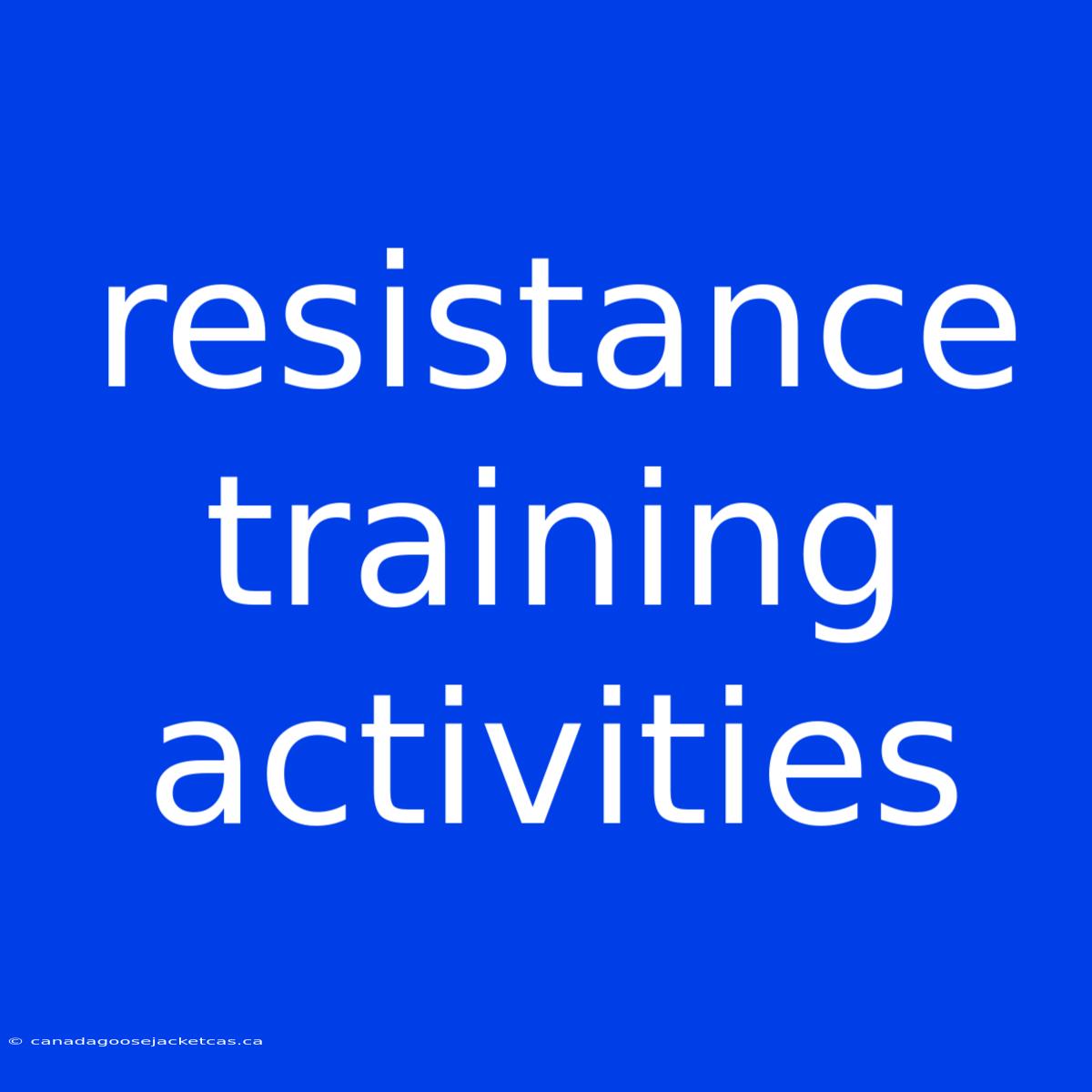Resistance Training Activities: Unlock Your Strength Potential
Are you looking to build muscle, increase strength, and improve your overall fitness? Resistance training activities are the key to unlocking your physical potential. Resistance training is a crucial component of a well-rounded fitness regimen, offering numerous benefits for people of all ages and fitness levels.
Editor Note: This article delves into the world of resistance training, providing insights and practical information to help you get started on your journey to strength and fitness.
Why is resistance training important? Resistance training, also known as strength training, focuses on challenging your muscles by using external resistance. This could involve using weights, bodyweight, resistance bands, or other equipment. This type of training not only strengthens your muscles but also improves bone density, increases metabolism, enhances coordination and balance, and boosts self-confidence.
Our Analysis: We have researched and compiled a comprehensive guide to resistance training activities. This article will dissect the different types of activities, highlight their benefits, and provide valuable tips to ensure you maximize your training experience.
Key Takeaways
| Aspect | Description |
|---|---|
| Types | Bodyweight, Weight Training, Resistance Bands, Kettlebells, Suspension Training |
| Benefits | Increased Muscle Mass, Improved Bone Density, Enhanced Metabolism |
| Safety | Proper Form, Gradual Progression, Listen to Your Body |
| Consistency | Regular Training Schedule, Progressive Overload |
| Customization | Adaptable to All Fitness Levels |
Let's dive into the different types of resistance training activities:
Bodyweight Training:
Introduction: Bodyweight training utilizes your own body as resistance, making it accessible and convenient.
Facets:
- Variety: Exercises like squats, lunges, push-ups, pull-ups, and planks offer a wide range of movements.
- Progression: Modifying exercises (e.g., wall push-ups to regular push-ups) allows for gradual progression.
- Accessibility: No equipment needed, making it ideal for home workouts or travelling.
Summary: Bodyweight training is a versatile and effective way to build strength and endurance.
Weight Training:
Introduction: Weight training involves using external weights, like barbells, dumbbells, and weight machines, to create resistance.
Facets:
- Specificity: Targeted muscle groups can be isolated for maximum growth.
- Progression: Weight can be increased incrementally as strength improves.
- Equipment: Requires access to a gym or home gym setup.
Summary: Weight training is the gold standard for building muscle mass and strength.
Resistance Bands:
Introduction: Resistance bands offer a versatile and portable way to add resistance to exercises.
Facets:
- Portability: Easy to pack and use anywhere, making it perfect for travel or home workouts.
- Variety: Can be used for a wide range of exercises, including squats, rows, and chest presses.
- Dynamic Resistance: Provides resistance throughout the entire range of motion.
Summary: Resistance bands are a great option for adding variety and challenge to your workouts.
Kettlebells:
Introduction: Kettlebells are unique weights that combine strength training with dynamic movements.
Facets:
- Functional Movements: Kettlebell exercises often mimic real-life movements, improving functional strength.
- Cardio and Strength: Combines cardiovascular benefits with muscle building.
- Variety: Offers a wide range of exercises, such as swings, snatches, and cleans.
Summary: Kettlebell training is an excellent way to improve power, coordination, and overall fitness.
Suspension Training:
Introduction: Suspension training utilizes straps and anchors to create resistance and challenge your body.
Facets:
- Bodyweight Resistance: Uses your bodyweight to create resistance, making it a versatile form of training.
- Core Engagement: Engages core muscles to stabilize and control movements.
- Full-Body Workouts: Can be used for a wide range of exercises, targeting different muscle groups.
Summary: Suspension training is an effective way to build strength, improve stability, and enhance flexibility.
FAQs about Resistance Training
Introduction: This section addresses common questions about resistance training.
Questions:
- Q: How often should I do resistance training?
- A: Aim for 2-3 sessions per week, allowing for rest days between workouts.
- Q: What should I eat after a resistance training workout?
- A: Consuming a protein-rich meal or snack within 2 hours of training helps with muscle recovery and growth.
- Q: Can I do resistance training if I have injuries?
- A: Consult a healthcare professional or certified trainer to adapt exercises to your specific needs.
- Q: What are the signs of overtraining?
- A: Fatigue, muscle soreness, decreased performance, and mood changes can indicate overtraining.
- Q: Do I need to lift heavy weights to see results?
- A: Even moderate weights can effectively build strength and muscle mass with proper form and consistency.
- Q: Is it safe for everyone to do resistance training?
- A: While generally safe, consult a healthcare professional if you have any underlying health conditions.
Summary: Resistance training is a safe and effective way to improve your overall health and fitness when done correctly.
Tips for Resistance Training
Introduction: Follow these tips for a successful and safe resistance training experience.
Tips:
- Warm-up: Start with 5-10 minutes of light cardio and dynamic stretching.
- Proper Form: Focus on proper technique to maximize results and prevent injuries.
- Progressive Overload: Gradually increase the weight, reps, or sets as you get stronger.
- Listen to Your Body: Take rest days when needed and don't push yourself beyond your limits.
- Variety: Incorporate different types of resistance training to challenge your muscles in new ways.
Summary: Following these tips will help you maximize your gains and enjoy a safe and effective resistance training journey.
Conclusion
Summary: Resistance training is a fundamental aspect of a holistic fitness approach. From bodyweight exercises to weight training and specialized methods like kettlebell training and suspension training, there are diverse options to suit individual preferences and goals.
Closing Message: Embracing resistance training activities can empower you to reach your fitness goals, enhance your strength and endurance, and unlock a healthier, more vibrant you. Remember, consistency, proper form, and gradual progression are key to achieving lasting results.

